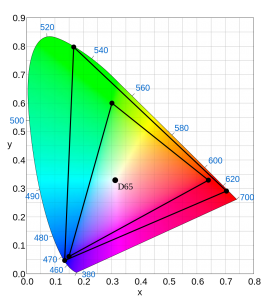What is this Ultra HDTV that you have been hearing about?
Ultra HDTV has been in the news, advertisements and finally in some stores. Here is the formal definition of what it is:
Ultra HD (also known as “Ultra High Definition” / “Super Hi-Vision” / “Ultra HDTV” / “UHD” / “UHDTV” / “4K” / “8K”), is a video format conceptualized by the Japanese public broadcasting network, NHK.
On October 17, 2012, The Consumer Electronics Association (CEA) announced that the official term “Ultra HD” would be used for any display with a 16 x 9 ratio with at least 1 digital input cable carrying a minimum resolution of 3,840 x 2,160 square pixels.

Ultra HD Technical Details
ITU Recommendation for Ultra HDTV
Recommendation BT.2020
(also known as “Rec. 2020″) was posted on the International Telecommunication Union (ITU) website on August 23, 2012. Rec. 2020 defines various aspects of ultra high definition television such as display resolution, frame rate, chroma subsampling, color depth, and color space.
Ultra HDTV Resolution
Currently there are 2 forms of Ultra HD, 4K and 8K, both have an aspect ratio of 16:9:
4K Ultra HD (2160p) has a resolution of 3840 × 2160 (8.3 megapixels), which is roughly equivalent to 4K cinema or 4 times the number of pixels in Full HD format (1080p).
8K Ultra HD (4320p) produces an astonishing 7,680 × 4,320 pixel resolution (33.2 megapixels), which is roughly the equivalent of an IMAX film or 16 times the pixel resolution of Full HD (1080p).
Ultra HD Frame rate
Rec. 2020 allows for Ultra HDTV frame rates of 120p, 60p, 59.94p, 50p, 30p, 29.97p, 25p, 24p, and 23.976p. Only progressive frame rates are allowed.
Ultra HD Digital representation
Diagram of the CIE 1931 color space that shows the Rec. 2020 (UHDTV) color space in the outer triangle and Rec. 709 (HDTV) color space in the inner triangle. Both Rec. 2020 and Rec. 709 use Illuminant D65 for the white point.
Rec. 2020 defines an Ultra HDTV color depth of 10-bits or 12-bits.
10-bits per component Rec. 2020 uses video levels where the black level is defined as code 64 and the nominal peak is defined as code 940. Codes 0-3 and 1,020-1,023 are used for the timing reference. Codes 4 through 63 provide video data below the black level while codes 941 through 1,019 provide video data above the nominal peak.
12-bits per component Rec. 2020 uses video levels where the black level is defined as code 256 and the nominal peak is defined as code 3760. Codes 0-15 and 4,080-4,095 are used for the timing reference. Codes 16 through 255 provide video data below the black level while codes 3,761 through 4,079 provide video data above the nominal peak.
Ultra HD Color space
The Rec. 2020 color space can reproduce colors that can not be shown with the Rec. 709 (HDTV) color space. In coverage of the CIE 1931 color space the Rec. 2020 color space covers 75.8%, digital cinema covers 53.6%, the Adobe RGB color space covers 52.1%, and Rec. 709 covers 35.9%
Ultra HD Luma coefficients
Rec. 2020 specifies that if a luma (Y’) signal is made that it uses the R’G’B’ coefficients 0.2627, 0.6780, and 0.0593.
Ultra HD Transfer characteristics
Rec. 2020 defines the non-linear transfer function that can be used for gamma correction. 10-bits per component Rec. 2020 uses the same formula that is used by Rec. 709. 12-bits per component Rec. 2020 makes a single change in the formula in that the minimum point on a 0 to 1 light intensity range where the non-linear transfer function begins is raised from 0.018 to 0.0181. Both Rec. 2020 and Rec. 709 use Illuminant D65 for the white point.
Ultra HD Upscaling
The Ultra HD 4K resolution of 3840 × 2160 simplifies video scaling from the popular high-definition source formats 720p and 1080p. A 1080p video source can be scaled perfectly by simply doubling each pixel horizontally and vertically, using 4 pixels on the Ultra HD 4K display to represent each pixel from the 1080p source. Similarly, a 720p source pixel can be tripled horizontally and vertically, using 9 pixels on the 4K display for each pixel from the 720p source. The 720p and 1080p resolutions will also evenly divide the 8K resolution of 7680 × 4320.
Other Ultra HDTV Details
In addition to the significant upgrade in video quality, sound quality is also significantly increased with Ultra HDTV. 24 channels of audio can be used with 24 speakers, producing a difference comparable to the Ultra HD video resolution.
Currently, only 3 cameras are able to capture video in Ultra HDTV format, and can only capture about 20 minutes (requiring 4 terabytes) in a single day. Needless to say, our current infrastructure is not designed to meet the Ultra HDTV requirements.
Several sources suggest that Super Hi-Vision technology will be used in the 2012 Olympics and will be widely available by 2020.
- September 29th, 2010 – NHK and BBC successfully broadcast a Super Hi-Vision signal from England to Japan.
- May 19th, 2011 – Sharp unveils its 85-inch Ultra HDTV prototype.
- April 28, 2012 – NHK unveils a 145-inch Ultra HD display.
- May 17th, 2012 – NHK transmits Ultra HD over-the-air.
- May 28th, 2012 – The ITU announces “Ultra High Definition Television” as the official name
- Q4 2012 – Several manufacturers announce Ultra HD televisions, including: LG, Sony, Sharp, and Samsung
- January 2013 – The Consumer Electronics Show in Las Vegas showcased several Ultra HD devices (Read the full review here)
The following diagram compares Ultra HD resolution to today’s currently available resolutions:

Call us for further details.
We invite you to call us at Lowell/Edwards on 201-525-3300 for more details.

